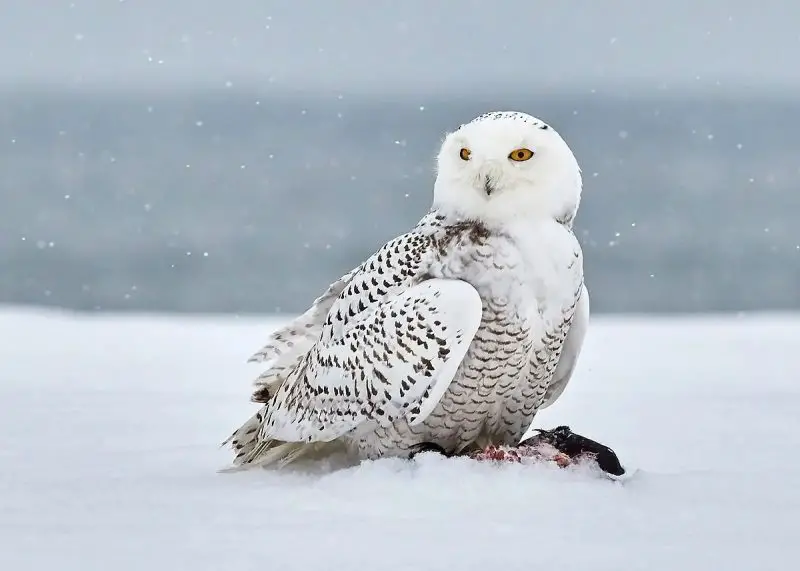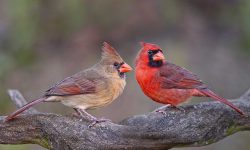The Snowy Owl (Bubo scandiacus) is a striking bird native to the Arctic regions of North America. Known for its pure white plumage and bright yellow eyes, this owl has captivated the imagination of many, including being the beloved companion of Harry Potter’s protagonist. While primarily an Arctic dweller, the Snowy Owl occasionally migrates south, making appearances in the northern United States during winter months.

Physical Characteristics
Size and Appearance
Snowy Owls are among the largest owl species in North America. Males typically measure between 55 to 64 centimeters in height, while females are slightly larger, ranging from 60 to 75 centimeters. Their wingspan can reach up to 1.5 meters, allowing them to glide silently through the air.
Males are generally pure white with minimal markings. Females are white with dark bars or spots, which provide camouflage in their natural snowy habitats. Juveniles resemble females but with heavier dark markings that help them blend into the tundra landscape.
Adaptations
Adapted to the harsh Arctic environment, Snowy Owls have several unique features that help them survive extreme cold. Their feet are covered in thick, fluffy feathers that act like natural boots, providing insulation against ice and snow. Their white plumage, often marked with dark spots, blends seamlessly with the snowy landscape, offering camouflage from predators and prey alike. Males are usually whiter, while females and juveniles have more markings for better concealment when nesting.
In addition to their plumage, Snowy Owls have exceptional eyesight and hearing. Their large, light-sensitive eyes allow them to detect prey even in low light, and their sharp hearing helps them locate animals hidden under snow. These adaptations make them efficient hunters perfectly suited for life in the Arctic tundra.
Habitat and Range
Breeding Grounds
Snowy Owls breed in the Arctic tundra, a cold, treeless region found at elevations below 300 meters. This landscape is dominated by low vegetation such as grasses, mosses, lichens, and dwarf shrubs. The flat, open terrain provides excellent visibility, making it ideal for ground nesting and spotting both prey and predators. Nests are simple scrapes on slightly raised ground, offering good drainage and a wide field of view. The tundra also supports an abundance of small mammals like lemmings, making it a prime hunting ground for Snowy Owls during the breeding season.
Winter Migration
During the colder months, Snowy Owls migrate south from the Arctic in search of food, sometimes traveling thousands of miles. In the United States, they are most frequently seen in northern states such as Alaska—where they also breed—as well as across the northern Great Plains and around the Great Lakes. These owls prefer open landscapes that mimic their tundra habitat, making them common sights in wide fields, coastal dunes, and even airports. Their preference for flat, open areas allows them to hunt effectively, just as they do in the Arctic.
Diet and Hunting Behavior
Primary Diet
Snowy Owls are opportunistic predators, primarily feeding on small mammals. In the Arctic tundra, their diet is dominated by lemmings, which can make up the majority of their food intake during the breeding season. A single owl may consume several lemmings per day, and a nest with chicks can require hundreds over the course of a season. When lemmings are scarce or during winter migration, Snowy Owls adapt by hunting other prey such as voles, mice, rabbits, and hares. In some regions, they may also take birds, including ducks and shorebirds, depending on availability.
Hunting Techniques
Feeding Habits
After capturing prey, Snowy Owls typically swallow it whole, including bones, fur, and other indigestible parts. Their strong digestive system processes the nutrients, while the undigestible materials are compacted into oval-shaped pellets, which the owl later regurgitates. These pellets often accumulate near roosting or nesting sites and provide valuable information to researchers about the owl’s diet, feeding habits, and local prey availability. This behavior is common among raptors and plays an important role in studying their ecological impact.
Reproduction and Lifespan
Nesting
Snowy Owls do not construct traditional nests like those of many other birds. Instead, the female scrapes a shallow depression directly into the ground, often choosing a slightly elevated spot such as a low mound or ridge. These simple nests are typically located in open tundra landscapes, where the wide, unobstructed view allows the owl to detect approaching predators or intruders. The nest may be lined with a few feathers or bits of vegetation, but it remains minimal, relying on the natural terrain for structure and protection.
Egg Laying and Incubation
Female Snowy Owls lay between three to eleven eggs per breeding season, with clutch size closely tied to food availability—larger clutches are more common when prey like lemmings are abundant. The female incubates the eggs for about 31 to 33 days, rarely leaving the nest, while the male hunts and brings back food. The eggs hatch asynchronously, usually a few days apart, which creates a size hierarchy among the chicks. This staggered hatching helps improve survival chances, as older, stronger chicks can outcompete younger ones during times of food shortage, and may even help keep younger siblings warm or alert the parents to incoming threats.
Chick Development
Snowy Owl chicks begin to leave the nest around two to three weeks after hatching, though they remain flightless and vulnerable during this period. They typically wander short distances on foot, hiding in nearby vegetation while waiting to be fed. Full flight capability develops by about seven weeks of age. During this time, both parents play active roles in caring for the young—the male continues to hunt and deliver food, while the female guards and tends to the chicks. Parental support continues until the juveniles become fully independent, usually by the end of the summer.
Lifespan
In the wild, Snowy Owls can live up to ten years, though some individuals may survive even longer under favorable conditions. However, many face significant threats that can shorten their lifespan, including predation, harsh weather, scarcity of food, and disease. Human-related dangers such as vehicle collisions, habitat disturbance, and exposure to toxins like rodenticides also contribute to mortality. Despite these challenges, Snowy Owls remain resilient birds, well adapted to life in some of the planet’s most extreme environments.
Behavior and Social Structure
Activity Patterns
Snowy Owls are primarily diurnal, meaning they are most active during the day—a trait that sets them apart from many other owl species. This daytime activity is particularly advantageous during the Arctic summer, when the sun remains above the horizon for nearly 24 hours. Their excellent vision allows them to hunt efficiently in bright light, scanning the tundra for movement. However, they are also capable of hunting at night when needed, especially during migration or in wintering grounds where daylight hours are shorter. This flexibility helps them adapt to varying light conditions throughout the year.
Territoriality
During the breeding season, Snowy Owls become highly territorial. Males establish and defend large territories by performing dramatic flight displays, vocalizing, and confronting intruders to attract the attention of females. These territories are selected based on prey abundance and suitable nesting sites. Once a pair forms, their bond remains strong throughout the season, with both partners cooperating closely in nesting, hunting, and raising their young. The male continues to defend the territory while the female focuses on incubation and chick care.
Communication
Snowy Owls use a variety of vocalizations to communicate, especially during the breeding season. Males are known for their deep, resonant “hoo” calls, which can carry over long distances and are used to establish territory and attract mates. Females typically produce softer sounds, including whistles, mews, and occasional harsh screams, often in response to threats or to communicate with their mate. Chicks emit high-pitched begging calls to signal hunger and prompt feeding. These vocal cues play a crucial role in maintaining family bonds and coordinating behavior within the nesting area.
Conservation Status
Population Estimates
Estimating the Snowy Owl population is challenging due to their highly nomadic and irruptive behavior, which causes their numbers and locations to vary widely from year to year. Despite these difficulties, recent studies estimate a global population of approximately 14,000 to 28,000 mature individuals. In North America, the population is believed to be fewer than 30,000 birds. These estimates may fluctuate depending on prey availability and breeding success, which are closely tied to lemming populations in the Arctic. Continued monitoring is essential to better understand long-term trends and conservation needs.
Threats
Snowy Owls face a range of threats, both natural and human-induced. Climate change is one of the most significant, as it disrupts the delicate balance of the Arctic ecosystem—altering lemming populations and reducing suitable nesting areas due to melting permafrost and shifting vegetation. Habitat loss caused by expanding human development, such as infrastructure and industrial activities, reduces the open spaces these owls rely on for hunting and breeding. Increased human presence, including tourism and research activity, can lead to stress, nest abandonment, or displacement. Additionally, natural predators like Arctic foxes, jaegers, and ravens pose serious risks to eggs and young chicks, especially in exposed nesting sites. Combined, these pressures threaten the stability of Snowy Owl populations and highlight the importance of ongoing conservation efforts.
Conservation Efforts
Conservation strategies for Snowy Owls focus on protecting critical habitats, especially in the Arctic breeding grounds and southern wintering areas. Efforts include monitoring population trends, studying migration patterns, and understanding how climate change and human activity affect their survival. Researchers and wildlife organizations conduct field studies to gather data on nesting success, prey availability, and movement. Public education is also a key component—raising awareness about the species’ ecological importance and the challenges they face. Many conservation groups collaborate with local communities to promote responsible land use, reduce disturbances, and encourage coexistence with these iconic Arctic birds.
Snowy Owls in the United States
Winter Visitors
During the winter months, Snowy Owls migrate south from their Arctic breeding grounds in search of more abundant food sources. In the United States, they are most commonly observed in states such as Alaska, Minnesota, the Dakotas, and New York, often appearing in open landscapes that resemble their tundra habitat. Their sudden arrivals, sometimes in large numbers during irruption years, often surprise and excite both bird watchers and researchers. These rare winter sightings provide valuable opportunities to study the species up close and raise public interest in Arctic wildlife conservation.
Human-Wildlife Interaction
Snowy Owls sometimes appear in human-populated areas during winter, especially in wide-open spaces like airports, which resemble the flat terrain of their native tundra. One notable example is Boston’s Logan Airport, where Snowy Owls have been regularly spotted. To prevent potential aircraft collisions, the airport has partnered with wildlife experts to implement humane relocation programs that safely capture and release the owls in more suitable habitats. These efforts not only protect the birds but also ensure aviation safety. Public education plays a key role in reducing disturbances, encouraging respectful observation, and fostering awareness about the species and its conservation.
Cultural Significance
In Indigenous Cultures
Among many Indigenous cultures, the Snowy Owl holds deep symbolic meaning. It is often seen as a messenger of wisdom, protection, and spiritual guidance. With its silent flight and piercing gaze, the owl is thought to possess insight beyond the physical world, making it a powerful totem in stories and traditions. The Snowy Owl is also associated with transition and transformation, representing change, intuition, and the unseen forces that guide life’s journey. These cultural interpretations highlight the reverence and respect Indigenous communities hold for this majestic Arctic bird.
In Modern Media
The Snowy Owl gained widespread global recognition through its portrayal as Hedwig, Harry Potter’s loyal and intelligent companion in the popular book and film series. Hedwig’s graceful presence and strong bond with Harry introduced millions of readers and viewers to the species, sparking fascination and admiration. This cultural exposure significantly boosted public interest in owls and contributed to broader awareness of their conservation needs. As a result, the Snowy Owl has become an iconic symbol in popular culture—representing mystery, loyalty, and the natural magic of the Arctic wilderness.
How to Spot a Snowy Owl
Best Viewing Times
The best time to observe Snowy Owls in the United States is during the winter months, typically from November to March, when they migrate south from the Arctic in search of food. Unlike many other owl species, Snowy Owls are primarily active during the day, especially in the early morning and late afternoon, which makes them easier to spot. Bird watchers often find them perched in open, windswept areas such as coastal dunes, agricultural fields, and airport runways—habitats that resemble their native tundra. Their striking white plumage and daytime activity make winter sightings particularly memorable.
Ideal Locations
Snowy Owls are typically found in open, treeless landscapes that mirror the Arctic tundra. During winter, they often settle in coastal areas, expansive agricultural fields, prairies, and even airports—locations that provide the wide, unobstructed views they rely on for hunting. Northern U.S. states such as Alaska, Michigan, Minnesota, and the Dakotas are among the best places to spot them. These regions offer the kind of open habitat Snowy Owls prefer, increasing the chances of a successful sighting during their seasonal migration.
Observation Tips
When observing Snowy Owls, it’s important to respect their space and natural behavior. Bring binoculars or a camera with a zoom lens to enjoy close-up views from a safe distance. Approach quietly, avoid sudden movements, and never attempt to feed or attract the owls. Disturbing them can cause stress or force them to leave valuable hunting or resting areas. Always follow local wildlife guidelines and posted signs, and remember that ethical birdwatching helps protect these majestic birds while allowing others to enjoy them as well.
Conclusion
The Snowy Owl is a symbol of the Arctic’s beauty and resilience. Its occasional appearances in the United States provide a rare opportunity to witness one of nature’s most majestic predators. As climate and habitat conditions continue to change, protecting the Snowy Owl is more important than ever. Through awareness, research, and conservation, we can help ensure that these stunning birds continue to grace our northern skies for generations to come.






